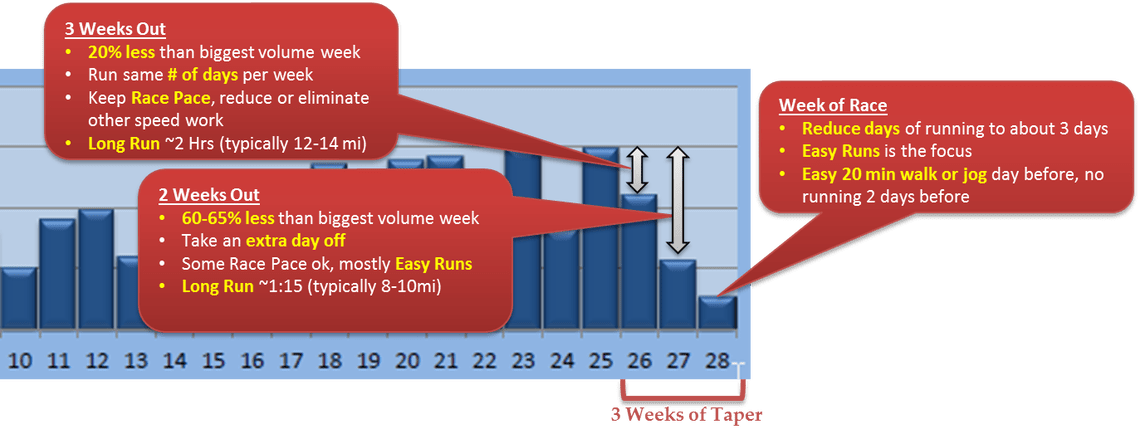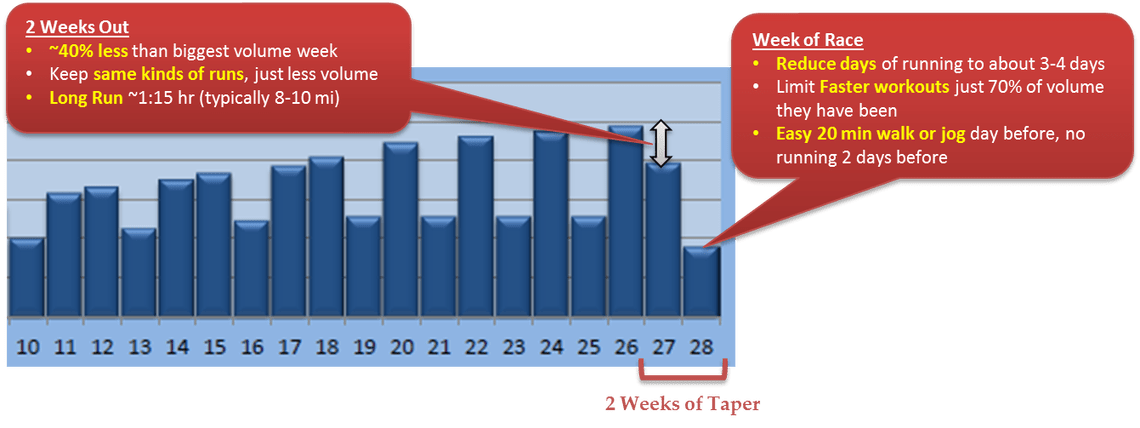How to Taper for your Marathon and Half-Marathon
Running, September 07, 2020
Tapering for a race is just like it sounds – doing less and less work in the final weeks of your training. The taper is important for peaking, and can have a bit of art and science to it. There are various views on how to accomplish the goals of tapering. Below are some commonly agree upon thoughts.

Goals of Tapering
Like anything else in training for an event, tapering isn’t done by happenstance. Many people look at tapering as non-training since you generally do less and less work. However, it is critical to getting you to the finish line at your best. Here are some goals of tapering:
- Increase Rest – your body has accumulated a lot of fatigue up to this point (on purpose), and we want to maximize on that during a taper. By focusing on resting more during the weeks leading up to your race, your body gets to work on building strength and getting to peak condition.
- Maximize Glycogen Stores – you’ve worked really hard up to this point to create the ability to store as much potential energy as possible through training. By utilizing less and less energy during a taper, your stores can be filled to the brim, and be extra ready for race day
And don’t worry. You won’t lose any fitness during these weeks of less activity. Tapering is a proven part of a training cycle, and although it feels weird, it is exactly what you need to have your best race. That’s why it’s critical to focus and trust.
Tapering for a Marathon
Generally speaking, the longer the race, the longer the taper. A marathon has a typical taper of 3 weeks. During these 3 weeks, you gradually reduce the volume of running you do while keeping some intensity. Here is some guidance:
3 weeks out – Reduce your total running volume by about 20% from your highest training week, which should be the one prior. You will generally run for the same number of days, just simply run for less time or miles. You can keep some speed work so you don’t get stale, Race Pace is common. And you should be shooting for a Long Run of about 2 hours (typically around 12-14 miles, or less for slower runners).
2 weeks out – Your total volume should be about 60-65% less than your highest training week and is accomplished by reducing your number of runs by 1 day, and further reducing your time and miles. Some speed work is ok but your focus should be on easy intensity. Your Long Run this week will be about 1 hour and 15 minutes (typically around 8-10 miles, or less for slower runners)
Week of Race – This is it! You don’t want to do a lot this week, and you’ll run around 3 days this week of easy intensity. You’ll want to have a day off 2 days before your race, and go for a walk or jog the day before, just 20 minutes or so.
Here is a visual of what this looks like:

Tapering for a Half-Marathon
Similar to the Marathon taper, the volume of running you do will get less. However, with a shorter race comes a shorter taper, and this one is just about 2 weeks. You can keep speed work in your plans, just less volume. Here is some guidance:
2 weeks out – Your total volume should be about 40-50% less than your highest volume week. You can keep the same kinds of runs you have been doing, just less volume. Your Long Run this week will be about 1 hour and 15 minutes (typically around 8-10 miles, or less for slower runners).
Week of Race – You’ll run around 3-4 days this week of various intensities, but higher intensity workouts should be reduced to just 30% of the volume you had been doing. You’ll want to have a day off 2 days before your race, and go for a walk or jog the day before, just 20 minutes or so.
Here is a visual of what this looks like:

Focus on Nutrition and Hydration During the Taper
There isn’t really a bad time to focus on eating what your body needs, but with as much building up your body is doing at this critical time, it would really benefit you to focus on what you put in your mouth. Here are some Nutrition and Hydration tips:
- Eat good quality protein – eating organic meats and plant products that contain protein is very important. Your body is in “build” mode and needs it. Try and focus on the good stuff.
- Eat good fats – the good fats from oils, fish, and plants are also critical to cell development, so this is not the time to go on a low fat diet. Minimize the bad fats, but don’t skimp on the good ones.
- Focus on micronutrients – don’t forget the colors of the rainbow. Make sure you eat many kinds of fruits and veggies as they contain truly what your cells crave.
- Don’t cut the salt – unless your doctor tells you to, of course. Otherwise, you’ll need the sodium on race day so keep the salt in your diet, and perhaps sprinkle a little extra.
- Increase focus on carbs – carb loading as it’s called. Focus on increasing the amount of carbs your meals have, but keep the meals normal size. Carb loading does not mean stuffing yourself with all you can eat spaghetti dinners and eating pastries all day. Focus on good quality carbs in normal amounts.
- Keep meal frequency high – Getting more carbs and nutrients is easier if you eat smaller, more frequent meals than only a few larger meals. It also keeps your metabolism more stable.
- Keep hydrated all the time – especially this week while your body is getting rid of waste, you’ll want to flush that out. Keep water with you at all times and sip on it (don’t guzzle)
Additional Tips for a Successful Taper
Finally, here are some additional tips for you as you finalize your training and get ready for the big day:
- Don’t try anything new during your taper – keep with what you know works
- Save the massage for after your race – unless you’ve been getting them on a consistent basis to this point, you’ll probably come away with more soreness and stiffness than good.
- Relax – don’t do anything strenuous during this time. Introducing too much activity will reduce the effectiveness of your taper.
- No strength training – this kind of training won’t help you now, and it may cause you harm.
- Don’t worry about losing fitness – this is good for you!
- Stay strong! Mentally, this time can be tough. Going from high volumes to less may make you nervous. Don’t be – you’ve put in the effort, now let your body repay you!
Happy Training!
Dan Cuson – Level 1 USAT Coach
